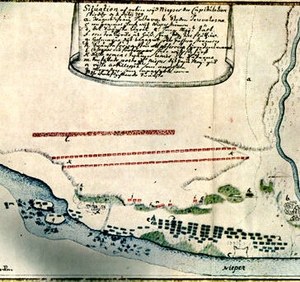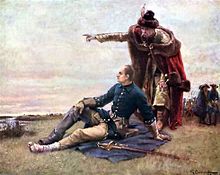Surrender at Perevolochna
| Perevolochna | |||||||
|---|---|---|---|---|---|---|---|
| Part of the Swedish invasion of Russia | |||||||
 Map depicting the surrender. Red=Russians and blue=Swedes. In the bottom left, Charles XII crosses the Dnieper along the two islands. Perovolocna is to the right, next to the Vorskla River. | |||||||
| |||||||
| Belligerents | |||||||
|
|
| ||||||
| Commanders and leaders | |||||||
| Adam Ludwig Lewenhaupt (POW) | Alexander Menshikov | ||||||
| Strength | |||||||
| 12,000[1]: 710 | 9,000[2]: 231 –20,000[2]: 246 | ||||||
| Casualties and losses | |||||||
| Entire army captured[2]: 246 [1]: 710 | |||||||

The surrender at Perevolochna was the capitulation of almost the entire Swedish army on 30 June 1709 (O.S.) / 1 July 1709 (Swedish calendar) / 11 July 1709 (N.S.). It signified the annihilation of the once formidable Swedish army after the defeat at Battle of Poltava, and paved the way for the eventual Russian victory in the Great Northern War. After the Battle of Poltava, Charles XII escaped to Moldavia, a vassal state of the Ottoman Empire.
Background[]
Leaving Pushkaryovka around 7 PM on the 28th, the same day as their defeat, the remnants of the Swedish army head south following the west bank of the river Vorskla to the river Dnieper, reaching Stari Sanzhary 20 km to the south where the baggage wagons stopped until dawn while the artillery, treasure-wagons and troops continue on to Novi Sanzhary.[2]: 210, 213 The artillery reached Novi Sanzhary after midnight, Charles XII at 1:30 AM, and the troops at dawn. The Tsar Peter the Great sent Prince Golitzin's Semyonovskiy Regiment and Christian Felix Bauer's ten regiments of dragoons in pursuit.[2]: 214
The march resumed by 7 AM on the 29th, heading for Bjeliki, and Major-General Meijerfeldt is sent back to negotiate with the Tsar.[2]: 214 The convoy linked up with Lt. Col. Silfverhielm's 500 men at Kobeliaky in the late afternoon.[2]: 216 On 30 June, the convoy reached Tashtayka on the Dnieper where Axel Gyllenkrok had been sent earlier to prepare a crossing.[2]: 220 However, Gyllenkrok wanted Charles to stop at Kishenka, and decide if they should cross the Vorskla at the ford and head into the Crimea, or head further south and attempt a crossing of the Dnieper into Turkey.[2]: 218 Now the Swedes found the Dnieper river broad and swift, with few materials with which to build boats or a bridge.[2]: 222 Ivan Mazepa and his men along with Silfverhielm's men crossed on the few boats available.[2]: 222 Efforts to swim across ended in drowning for men and horse alike.[2]: 224
The Swedish command convinced Charles to save himself by crossing the Dnieper and heading for Ochakov, while the army, led by Lewenhaupt, would cross the Vorskla into the Crimea.[2]: 225 About 3,000 crossed that day and night with the king, mostly officers and members of the royal household.[2]: 227
The surrender[]
The dawn of the next morning brought news that a Russian corps of infantry, cavalry and artillery was deployed in a crescent shape, ready for battle, on the plateau above the river, about 9,000 men under the command of General Menshikov.[2]: 231 The Cossacks allied with the Russians, swept down to plunder the Swedish wagons.[2]: 233 The Russian army advanced and blocked the road to Kishenka and a Swedish escape.[2]: 233 The Swedish army now faced the sandhills and the Russian army on the plateau.[2]: 234
Lewenhaupt did not want to fight the Russians, instead sending the Prussian military attache to start truce negotiations.[2]: 234 After conferences and voting among the higher officers,[2]: 243 the Swedish army of 12,000[1]: 710 to 20,000 capitulated.[2]: 246 The king departed the southern river bank at 9:45 AM while the announcement of surrender was made at 11 AM.[2]: 236, 243 The Russians executed the Cossacks allied with the Swedes, unable to escape across the Dnieper.[3]: 294
Effect on the war[]
The surrender was a contributing cause to the Russian victory in the Great Northern War. The Swedish continental army had ceased to exist, leaving the remaining defenses of the Swedish Empire hopelessly outnumbered. Strategically, Russia now had taken the offensive, while Sweden would be hard pressed to muster a new army to defend itself. General Lewenhaupt was imprisoned and died in Russian captivity in 1719. King Charles did nothing to have him released, but fled to Bendery in what was then Ottoman Empire.[1]: 710
References[]
- ^ a b c d Tucker, S.C., 2010, A Global Chronology of Conflict, Vol. Two, Santa Barbara: ABC-CLIO, LLC, ISBN 9781851096671
- ^ a b c d e f g h i j k l m n o p q r s t u v Englund, P., 1992, The Battle that Shook Europe, London: I.B. Tauris & Co. Ltd., ISBN 9781780764764
- ^ Frost, R.I., 2000, The Northern Wars, 1558-1721, Harlow: Pearson Education Limited, ISBN 9780582064294
![]() This article contains content from the Owl Edition of Nordisk familjebok, a Swedish encyclopedia published between 1904 and 1926, now in the public domain.
This article contains content from the Owl Edition of Nordisk familjebok, a Swedish encyclopedia published between 1904 and 1926, now in the public domain.
- Great Northern War
- 1709 in Europe
- Surrenders
- 1709 in Russia
- 1709 in military history
- History of Poltava Oblast
